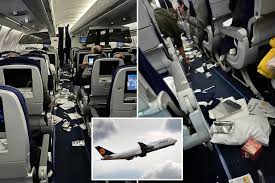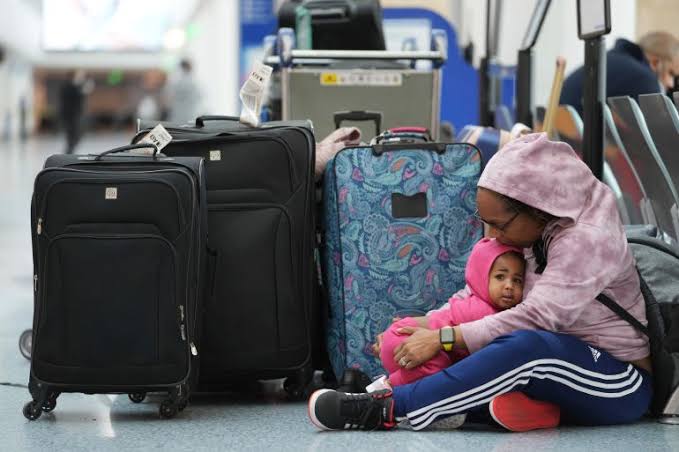Shocking’ turbulence that hit Lufthansa flight from Texas puts seven in hospital
‘Shocking’ Turbulence That Hit Lufthansa Flight From Texas Puts Seven in Hospital
A Harrowing Journey Across the Atlantic
Passengers aboard Lufthansa Flight LH469 will likely never forget the terror they experienced on what was supposed to be a routine journey from Austin, Texas, to Frankfurt, Germany. Severe turbulence struck the Airbus A330 as it cruised at altitude, causing chaos in the cabin and leaving seven individuals hospitalized after the emergency landing.

The incident has reignited debates about aviation safety, the unpredictability of weather phenomena, and the psychological impact of turbulence on passengers and crew. Here’s a comprehensive breakdown of what happened, why such turbulence occurs, and how the aviation community is responding.
The Incident: A Routine Flight Turns Nightmarish
Flight LH469 departed Austin-Bergstrom International Airport on time and initially proceeded uneventfully. Passengers described a calm, ordinary flight until the aircraft, flying over Tennessee at around 37,000 feet, encountered what experts categorize as “severe turbulence.”
Without warning, the aircraft violently shook, with some passengers being thrown from their seats. Food trays, drinks, and even personal items were reportedly sent flying across the cabin. In the aftermath, several passengers and flight attendants suffered injuries, mostly to the head, neck, and back, due to the sudden and extreme motion.
Crew members quickly assessed the situation and determined that a diversion was necessary. The pilots declared a medical emergency and rerouted the aircraft to Washington Dulles International Airport (IAD), where it made a safe landing. Emergency services were on hand to meet the aircraft, and seven individuals were transported to local hospitals for further treatment.
First-Hand Accounts Paint a Frightening Picture
Passengers shared harrowing stories once safely on the ground. One traveler described the scene as “absolute chaos,” recalling how people not wearing seatbelts were launched from their seats.
“It felt like we were in a car crash in midair,” one passenger recounted. “The plane just dropped and shook so violently—there was screaming, things were breaking, it was just total panic.”
Another traveler said, “Flight attendants were hurt too. You could see the fear in everyone’s eyes.”
Despite the injuries and fear, many passengers praised the Lufthansa crew for their professionalism and quick response, which ensured the situation didn’t escalate further.

Understanding Turbulence: What Makes It So Dangerous?
Turbulence is a common occurrence in air travel, but what makes certain instances so catastrophic? Aviation experts point to a phenomenon known as Clear Air Turbulence (CAT)—sudden and severe turbulence that occurs in clear skies without any visual warning.
Unlike turbulence associated with thunderstorms, CAT is nearly impossible to detect with onboard radar systems. It often occurs at high altitudes, typically near jet streams, making it particularly dangerous for cruising aircraft.
Dr. Alan Bruckner, an aviation meteorologist, explains: “Pilots are trained to anticipate and avoid turbulence as much as possible, but CAT can appear out of nowhere. It’s like hitting a pothole on a highway you thought was smooth.”
Factors that likely contributed to the turbulence faced by LH469 include strong jet streams and atmospheric instability common during seasonal transitions from winter to spring.
The Role of Seatbelts in Preventing Injury
The Federal Aviation Administration (FAA) and aviation experts repeatedly emphasize the importance of keeping seatbelts fastened whenever seated, even when the seatbelt sign is off.
In the case of Flight LH469, many of those injured were not wearing seatbelts at the time the turbulence struck. While this isn’t unusual—many passengers feel safe unbuckling once the flight seems smooth—it underlines a critical point: severe turbulence can occur without warning.
“Had everyone been buckled up, the number of injuries would have been much lower,” says Captain Jeremy Ford, a veteran pilot with over 20 years of experience. “It’s not about inconvenience; it’s about physics. A plane dropping or jolting suddenly can throw an unbuckled passenger into the ceiling.”
Lufthansa’s Response and Investigation
Lufthansa immediately issued a statement expressing regret over the incident and offering full support to affected passengers and crew. The airline launched an internal investigation in cooperation with the relevant aviation authorities, including the U.S. Federal Aviation Administration and Germany’s Federal Bureau of Aircraft Accident Investigation (BFU).
A Lufthansa spokesperson stated: “The safety and well-being of our passengers and crew are our highest priority. We are working closely with authorities to understand the circumstances that led to this event.”
The German carrier also arranged accommodations for the passengers and made special arrangements for the continuation of their travel plans.
Broader Implications for Aviation Safety
The incident has sparked renewed attention to aviation safety protocols regarding turbulence. While commercial aviation remains statistically the safest mode of transportation, events like these remind travelers and airlines alike that risk can never be fully eliminated.
Aviation regulators worldwide are continually refining turbulence prediction models and encouraging airlines to invest in newer technology, such as LIDAR systems, that might help detect Clear Air Turbulence earlier.
However, widespread adoption of such technology is still years away due to cost, weight, and integration challenges.
The Psychological Toll of In-Flight Emergencies
While physical injuries were the immediate concern following LH469’s emergency landing, mental health experts highlight the often-overlooked psychological impact of such traumatic experiences.
Fear of flying, or aviophobia, affects approximately 6.5% of the population, according to the National Institute of Mental Health. Experiencing a severe turbulence event can either trigger or exacerbate this fear.
Dr. Elaine Jacobs, a clinical psychologist specializing in trauma, notes: “For some passengers, it may take months—or even years—to feel comfortable flying again. Others might avoid air travel altogether without therapy and support.”
In recognition of this, airlines like Lufthansa offer post-incident counseling and support services to passengers involved in distressing flights.
How Passengers Can Stay Safe During Turbulence
Although turbulence can’t be entirely avoided, there are several proactive steps passengers can take to minimize risk:
Always keep your seatbelt fastened while seated, even if the ride feels smooth.
Follow crew instructions immediately and without hesitation.
Store heavy items properly in overhead bins or under seats to prevent them from becoming dangerous projectiles.
Stay seated during service whenever possible, especially when the seatbelt sign is on.
Mentally prepare for turbulence by understanding that, while frightening, modern aircraft are designed to withstand extreme forces far beyond normal turbulence.
Conclusion: A Wake-Up Call at 37,000 Feet
The shocking turbulence encountered by Lufthansa Flight LH469 is a stark reminder of the unpredictable nature of flight. It highlights the resilience of modern aircraft, the importance of crew preparedness, and the vital role of basic safety habits, like wearing seatbelts.
As investigations continue and affected passengers recover, the aviation community will undoubtedly examine what lessons can be learned to improve detection, prevention, and response to such midair emergencies.
For now, travelers are reminded: while the skies are safer than ever, respect for the power of nature—and adherence to safety protocols—remains as important as ever.






